Having one of the best binoculars can be crucial for anyone interested in astronomy. In this handy guide, we’ve pulled together our recommendations of the best binoculars on the market in 2022.
Optical quality is a major consideration when buying one of the best binoculars — so look out for models that have fully multi-coated optics and use BAK-4 glass for the prisms. You might also think the the best binoculars have the highest magnifications but this isn’t always the case. The reason binoculars deliver amazing views of the night sky is because they collect more photons than the naked eye. This is down to the size of the objective lens, so going for bigger objectives rather than higher magnifications would be a good way to go.
As a rule of thumb, popular binoculars offer 8x, 10x and 12x magnifications, while big pairs can go up to 20x and 25x. In terms of objective lens diameters, they’re usually in the range of 30-50mm but can go up to 100mm and more.
When it comes to binoculars, bigger isn’t always better so make sure you check out our best compact binoculars and best binoculars for kids guides. We also have brand specific binoculars guides for Vortex deals, Bushnell deals and Leica deals.
If you are wanting the absolute best binoculars on the market right now, then read on below to find out what we suggest.
Ask any seasoned astronomer which is the best binocular magnification for getting started in skywatching and the answer will be 10×50. However, the TrailSeeker 8×42 from Celestron offers a slightly different view to the norm — and it’s all down to the amount of light the 42 mm apertures collect during observations. What’s more, the lower magnification offers a wider field of view over 10x50s.
While the moon, for example, appears a touch smaller through this binocular than through the barrels of 10x50s, the optical system combined with multi-coated optics offers a much crisper and brighter image. Compared to other binoculars we’ve tested and thanks to nitrogen purging and a waterproof design, the optics didn’t fog up either, especially when used in a variety of ambient temperatures and when moving between the warmer indoors and frostier outdoors.
Another advantage of the Celestron TrailSeeker 8×42 is the lack of false color — also known as chromatic aberration — which often takes the form of a purple or blue hue around brighter targets. Very little is detected in the field of view, particularly along the limb of the moon, as we studied a plethora of craters, rilles and lunar mare on its rugged terrain.
Star clusters such as the Beehive Cluster (Messier 44) in Cancer (the Crab), look stunning through the TrailSeeker 8×42 — like jewels studded in a velvet-black background. Meanwhile, Venus appeared as a bright disk with no false color.
The TrailSeeker 8×42 binocular is also quite light at 2 lbs. (1.0 kilograms). But over long periods of observing time, we discovered that our arms began to shake making it difficult to get a steady hand-held view: if you’re prone to trembling arms, a tripod is definitely a recommended accessory.
The Celestron TrailSeeker 8×42 is hard to come by in the U.S, so prices may be higher than normal. Try these great alternatives instead:
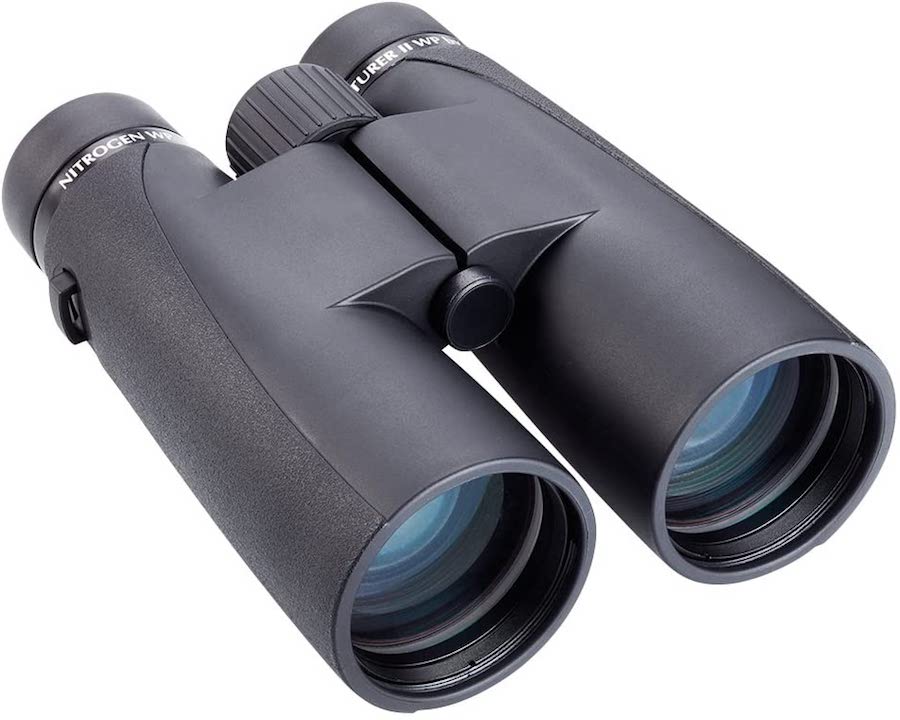
Sometimes, when optical instruments are being designed, consideration is not always given to astronomers who wear spectacles. These observers often find that their eyes cannot get as close to the eyecups or eyepieces of binoculars and telescopes, forcing them to remove their glasses for a comfortable view.
The Opticron Adventurer II WP 10×50 binocular is the perfect solution for spectacle wearers, since an excellent eye relief of 0.7 inches (17.78 mm) is offered — eye relief being the distance from the eyepiece at which the user can still see the entire field of view. The binocular also features twistable eyecups that can retract or extend, making the Opticron Adventurer II WP 10×50 more comfortable, whether you wear glasses or not.
So how about the view? The optics are excellent and provide great contrast, showing all the usual suspects well: open star clusters like the Pleiades (Messier 45) in Taurus (the Bull) and the Beehive (Messier 44) in Cancer (the Crab) were picked out with ease and are viewed with high clarity, while bright double stars — particularly Mizar and Alcor in the constellation of Ursa Major (the Great Bear) — resolve well under the magnification. Additionally no fogging was noted during our observations and during tests under a variety of temperatures.
Sweeping through the Milky Way to take in a huge collection of stars through the Opticron Adventurer II WP 10×50’s 5.5-degree field of view is breathtaking and, weighing in at 1.7 lbs. (0.77 kg) this binocular can be held comfortably for long periods of observing time.
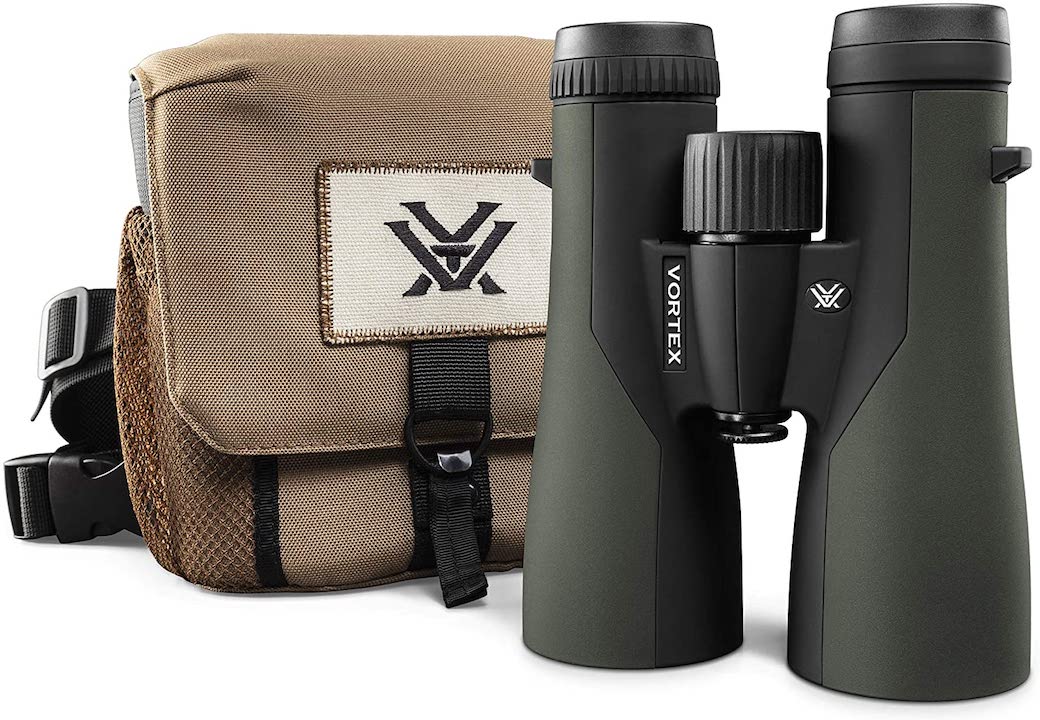
The sturdy, well-constructed Vortex 10×50 Crossfire HD binocular is primarily intended for terrestrial observations or watching wildlife in action. That’s not to say that they can’t be turned skyward, though.
Through the field of view, the sights are crisp and clear, with stars appearing as perfect pinpoints of light. However, we did detect a degree of false color when observing brighter targets: the moon and Jupiter, for example, were tinged with a blue-to-purple hue around their outer edges — it’s worth noting that this optical defect isn’t unusual at this price point. Additionally, our views of the night sky were not ruined and we enjoyed our tour with the Vortex 10×50 Crossfire HD.
In terms of build, this binocular is well-constructed with a solid, heavy-duty focusing knob that’s a breeze to adjust even when wearing thick gloves to fend off chilly winter temperatures. An added bonus is that the eye relief is adjustable thanks to twistable eyecups, allowing the skywatcher to find a setting that’s most comfortable for observing.
At 1.89 lbs. (0.86 kilograms), astronomers who like to dabble in nature-watching and globetrotting will be grateful for the manageable weight: we discovered that the Vortex 10×50 Crossfire HD binocular is easy to hold for long periods of time when observing the night sky, allowing us to take in steady, high-definition views of the moon’s surface, bright planets and deep-sky targets.
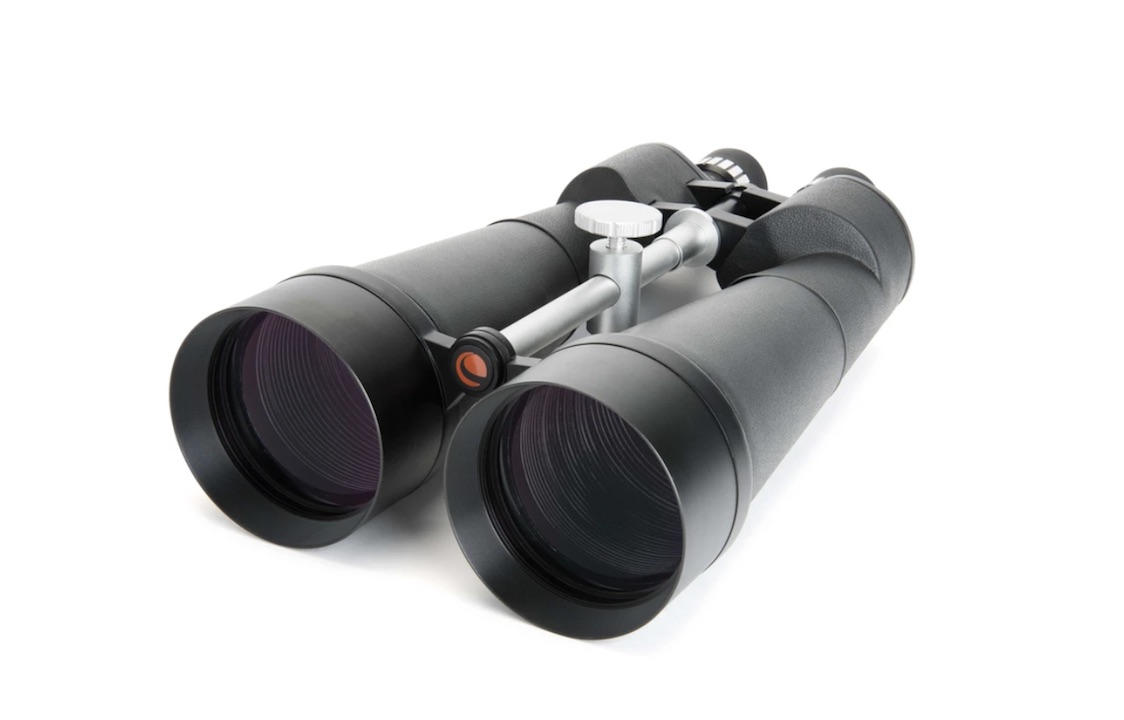
The Celestron SkyMaster 25×100 binocular is truly like a pair of giant telescopes: touring the heavens with them is like viewing the night sky using two four-inch (100 mm) refractors, with added 25x magnification. At 15.3 inches (388.62 mm) in length and weighing in at 8.75 lbs. (4 kilograms), you will need a heavy-duty tripod for prolonged use. The eye relief is decent at 0.6 inches (15.24 mm).
Held steady on a tripod using the integrated tripod adapter rod, with a dark, clear night sky, you can just about perceive Jupiter’s atmospheric belts in the field of view. While sweeping through the Milky Way, particularly the dense star fields of the summer Milky Way in Sagittarius is a sight has to be seen to be believed: gaggles of stars dominated the field of view, especially when we hit the Sagittarius Star Cloud (Messier 24). We could grip the barrels with ease, thanks to the binocular’s ultra-firm rubber grip.
The multi-coated optics are exquisite, with bright images and stunning contrast. The moon and its craters, rilles and mare look outstanding in the three-degree field, with the only real downside in the optics being a slight false-color fringe around brighter targets. Considering the aperture gathers as much light as a single 6-inch refractor but for far fewer dollars, the Celestron SkyMaster 25×100 binocular is highly recommended — especially if you’re on a tight budget.
The Celestron SkyMaster 25×100 binocular is sturdy and well manufactured, offering years of observations. A nylon padded carrying case and lens covers are also included.

Nikon has an excellent reputation for quality in all kinds of optical devices, from cameras to spotting scopes and that quality is maintained in the 10×50 Aculon A211 binocular.
All the usual binocular targets are picked out with ease including Jupiter’s disk to the crescent moon, with the optical system revealing crisp shadows at our natural satellite’s terminator — the point where lunar day meets lunar night. The aspherical eyepiece lens built into the Nikon 10×50 Aculon A211 binocular works like a charm, eliminating any kind of image distortion for a fantastic skywatching experience. The rubber armour allowed for a firm, shock-resistant grip that made the binoculars a pleasure to hold during our observations.
The 6.5-degree field of view is fairly large, allowing you to feel like you’re falling through space, and is perfect for those occasions when the moon passes through or close to a large star cluster, such as the Pleiades (Messier 45) in Taurus (the Bull). Pinpoint stars litter the backdrop of a dark night sky right to the edge of the frame, and the contrast in view is exquisite.
Where the Aculon A211 slightly lets itself down is with the rather paltry eye relief of just 0.5 inches (16.51mm), which will be problematic for spectacle wearers. Additionally, this binocular is not waterproof. However, if you have the budget, the Nikon Aculon A211 is a worthwhile piece of kit for those looking for brilliant, wide-angle views of the night sky.
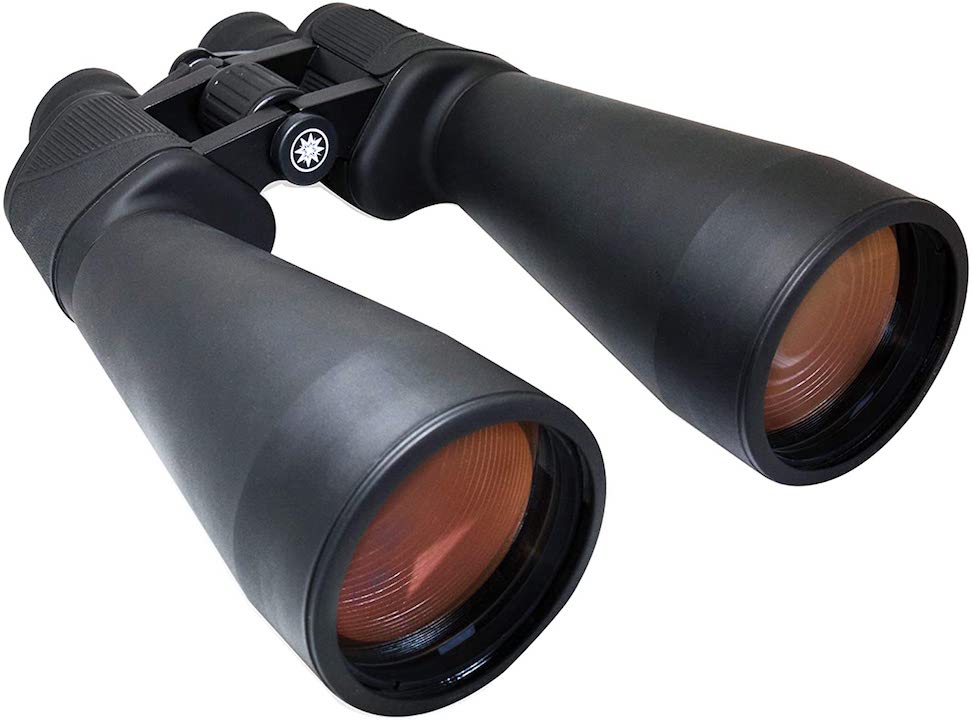
Meade Instruments’ 15×70 Astro Binocular will reveal pleasing views of the lunar surface, the planets and the brightest deep-sky objects.
The binocular is reasonably priced for its magnification, with only a slight degree of false color as we slewed from one bright target to the next. What’s more, there’s no fogging on the optics during temperature changes.
Through the 15×70 Astro Binocular we were able to spot Saturn’s ansae (the extension of the rings at either side of the planet, giving it an oblate shape) but weren’t able to resolve them as rings. Meanwhile, Jupiter appeared bright in the field of view, but the magnification isn’t quite great enough to see the gas giant’s atmospheric bands or Great Red Spot. What you can see though is Jupiter’s moons with ease compared to binoculars with lower magnification. Sweeping over to our moon, the craters are a sight to behold and are breathtaking, with the lunar surface appearing voluminous in the 4.4-degree field of view.
These binoculars are heavy, weighing in at 3.1 lbs. (1.4 kilograms) so the additional purchase of a tripod and adaptor, if you don’t already own one, is strongly recommended to make the most of the Meade 15×70 Astro Binocular.
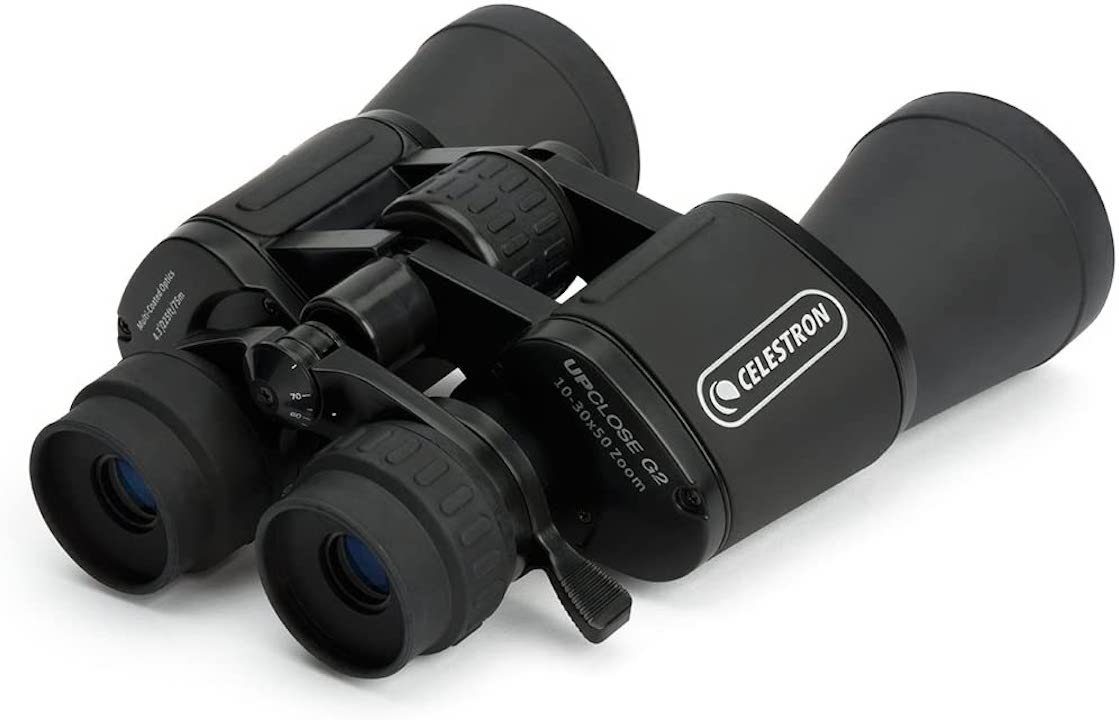
Celestron’s budget-priced binocular is a great entry point into skywatching for the beginner but be warned that while there are bags of positives in terms of build and optical prowess, the low price does come with some caveats.
The view they present is very reasonable: the fuzzy glow of the Orion Nebula (Messier 42) is pleasing and we could just make out three stars in the Trapezium Cluster at the nebula’s heart — greater magnification would be needed to tease out the fourth bright star in this star-forming region.
The moon is a stunning sight, fitting in the field of view comfortably and with a slight degree of false color. During July 2020, the UpClose G2 10×50 binocular served as an excellent optical aid for studying the naked-eye comet C/2020 F3 (NEOWISE).
Where the view was let down is by the collimation of the lenses being off, but this can be adjusted via small screws — albeit this shouldn’t have to be done for a new binocular straight out of the box. The lenses also have a habit of fogging over, which can be irritating, but wasn’t a major dealbreaker: the Celestron UpClose G2 10×50 binocular is still recommended for its lightweight design and low cost.
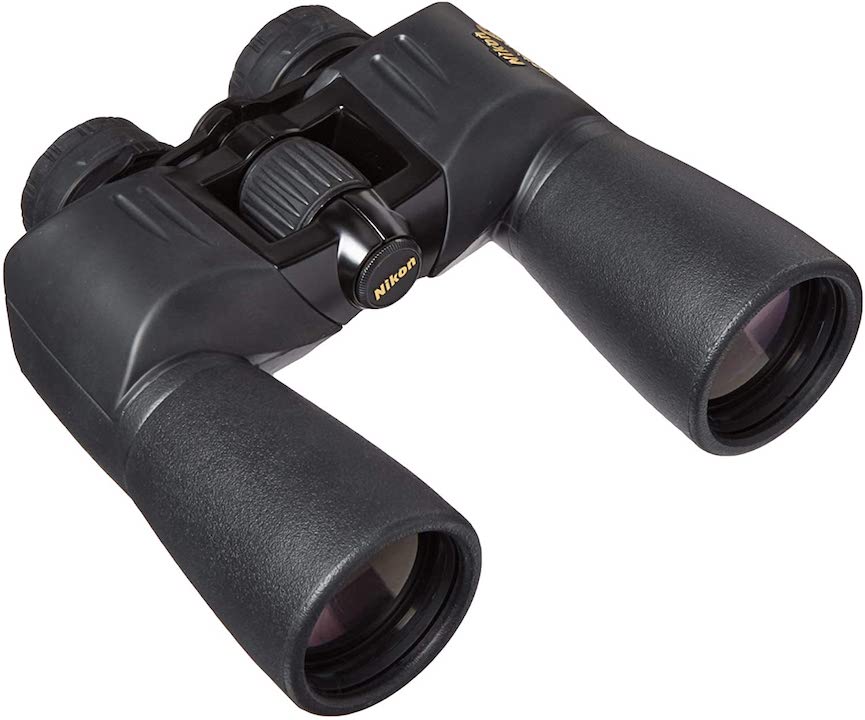
The Nikon Action EX 12×50 binocular makes for a good comparison with regular 10×50 binoculars, in that you get the same aperture at 50 mm but a greater magnification of 12x. The build is of high-quality, with comfortable rubber grips and a large focus knob that features a good range. Eye relief is very good at 0.51 inches (13 mm).
Since you’re magnifying the same amount of light collected by 10x50s, a higher magnification usually means images are less bright. However, thanks to the multi-coated lenses and high-refractive-index prisms of the Action EX 12×50, this loss of brightness is not really noticeable. What you get are great, high-contrast images. Saturn offered a test of this binocular: its rings were not resolvable on their own, but the skywatcher will notice definite ansae — the extension of the rings at either side of the planet, giving Saturn an oblate shape.
When viewing stars, the images are sharp and pinpoint at the centre of the field. There does, however, seem to be some curvature around the edge of the 5.5-degree field of view, which will prove slightly irritating when sweeping through the Milky Way or observing large star clusters — however, this doesn’t detract from the excellent package the skywatcher gets in the Action EX 12×50.
The Nikon Action EX 12×50 is a heavy binocular though, weighing in at 2.3 lbs. (1.04 kilograms), and the higher magnification will enhance any shakiness, so skywatchers are strongly recommended to procure a tripod.
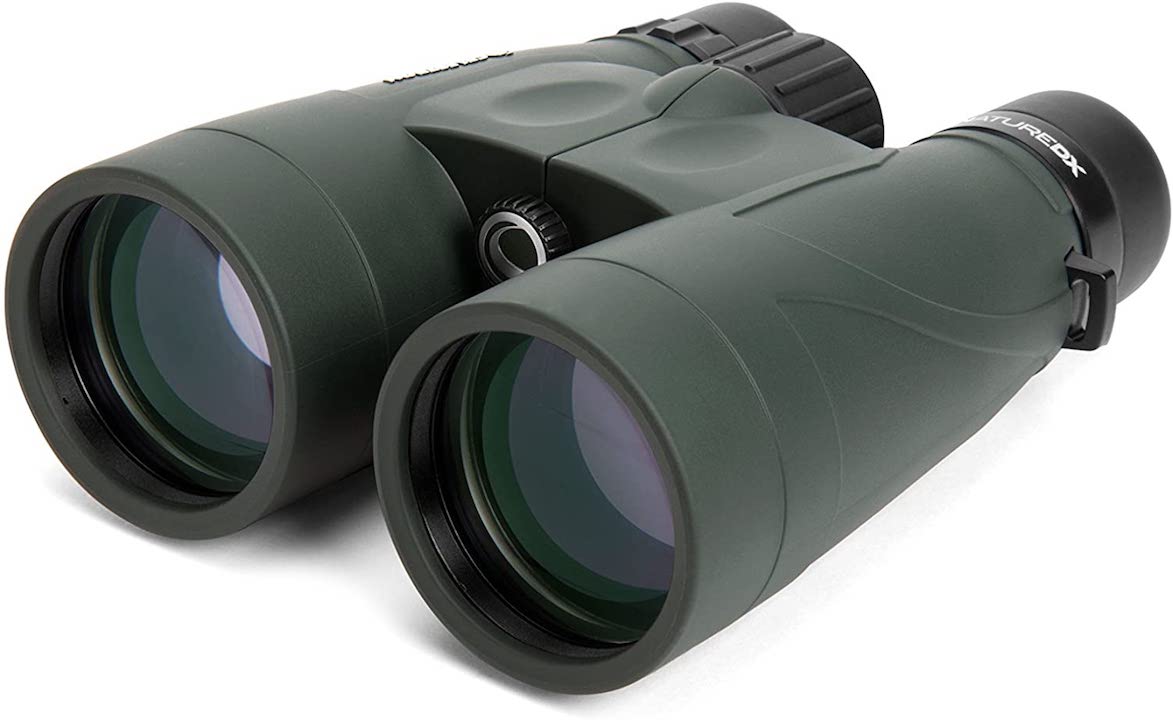
This relatively unusual combination of 12x magnification and 56 mm aperture objective lenses combines power with light-gathering ability, while still being small and light enough to be handheld comfortably with steady hands.
It’s noticeable how better they show galaxies than smaller models — the Andromeda Galaxy (Messier 31) appears disk-shaped with hints of structure, while the neighboring Bode’s Galaxy (Messier 81) and Cigar Galaxy (Messier 82) in Ursa Major (the Great Bear) look outstanding in the same 5.5-degree field of view. Turned towards the moon, the craters exude superb clarity and contrast.
There is a slight amount of distortion through the optical system that begins about three-quarters of the way from the center of the field, with some stars displaying a degree of softness. These stars took the appearance of blobs rather than points of light. The Celestron Nature DX 12×56 is waterproof and also keeps fogging at bay.
In terms of build, the binocular is pretty good. The rubber handholds are comfortable, the 0.6-inch eye relief is generous and at 2.27 lbs. (1.03 kilograms) they weigh fractionally less than the Nikon Action EX 12×50, but with more aperture to play with.

Celestron’s SkyMaster range of binoculars, while not intended to be top of the range, provide quality views with affordability, and that’s certainly what you get from the 15×70 “giant” binocular.
At 11-inches (280 mm) in length and weighing 3 lbs. (1.36 kilograms) the Celestron SkyMaster 15×70 binocular certainly has a lot of heft, but it’s not impossible to use them as a hand-held piece of kit — strong and steady arms will certainly be needed, but it’s more comfortable to use a tripod if you have one.
Despite the larger 70 mm objective aperture, the higher magnification of 15x reduces the apparent field of view to 4.4 degrees, compared to typical 10x50s or 12x50s that provide a degree more.
That said, the more light gathered and higher magnification makes details pop out that are more vague, or fuzzy, when observed through smaller binoculars. There is some softness and blurring towards the edge of the field, which is disappointing but not unexpected for this price point, but if you are a spectacle-wearer then you’ll be delighted to read that the SkyMaster 15×70 has an impressive 0.7 inches (18 mm) of eye relief.

